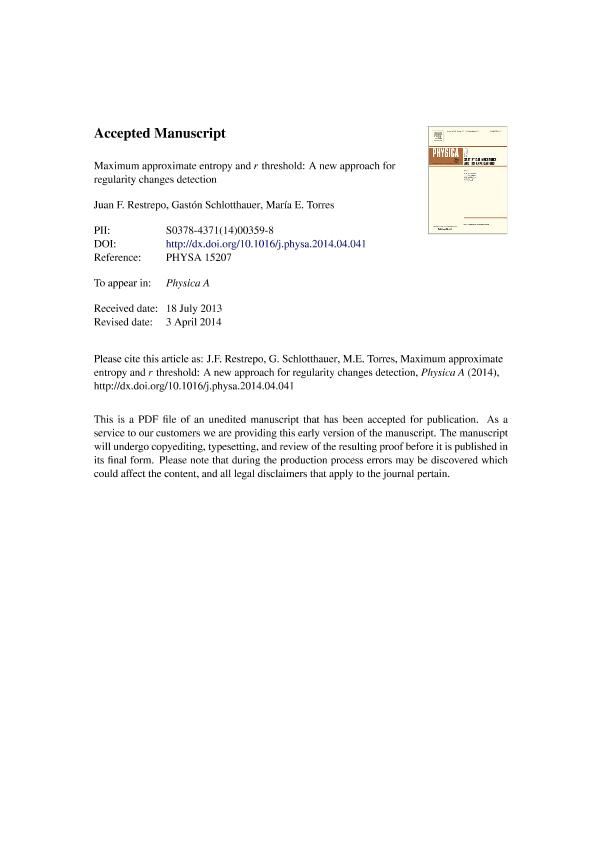Mostrar el registro sencillo del ítem
dc.contributor.author
Restrepo Rinckoar, Juan Felipe

dc.contributor.author
Schlotthauer, Gaston

dc.contributor.author
Torres, Maria Eugenia

dc.date.available
2018-01-17T15:17:05Z
dc.date.issued
2014-05
dc.identifier.citation
Restrepo Rinckoar, Juan Felipe; Schlotthauer, Gaston; Torres, Maria Eugenia; Maximum approximate entropy and threshold: A new approach for regularity changes detection; Elsevier; Physica A: Statistical Mechanics and its Applications; 409; 5-2014; 97-109
dc.identifier.issn
0378-4371
dc.identifier.uri
http://hdl.handle.net/11336/33590
dc.description.abstract
Approximate entropy (ApEn) has been widely used as an estimator of regularity in many scientific fields. It has proved to be a useful tool because of its ability to distinguish different system’s dynamics when there is only available short-length noisy data. Incorrect parameter selection (embedding dimension m, threshold r and data length N) and the presence of noise in the signal can undermine the ApEn discrimination capacity. In this work we show that rmax (ApEn(m,rmax,N)=ApEnmax) can also be used as a feature to discern between dynamics. Moreover, the combined use of ApEnmax and rmax allows a better discrimination capacity to be accomplished, even in the presence of noise. We conducted our studies using real physiological time series and simulated signals corresponding to both low- and high-dimensional systems. When ApEnmax is incapable of discerning between different dynamics because of the noise presence, our results suggest that rmax provides additional information that can be useful for classification purposes. Based on cross-validation tests, we conclude that, for short length noisy signals, the joint use of ApEnmax and rmax can significantly decrease the misclassification rate of a linear classifier in comparison with their isolated use.
dc.format
application/pdf
dc.language.iso
eng
dc.publisher
Elsevier

dc.rights
info:eu-repo/semantics/openAccess
dc.rights.uri
https://creativecommons.org/licenses/by-nc-nd/2.5/ar/
dc.subject
Non-Linear Dynamics
dc.subject
Approximate Entropy
dc.subject
Chaotic Time-Series
dc.subject.classification
Ingeniería de Sistemas y Comunicaciones

dc.subject.classification
Ingeniería Eléctrica, Ingeniería Electrónica e Ingeniería de la Información

dc.subject.classification
INGENIERÍAS Y TECNOLOGÍAS

dc.title
Maximum approximate entropy and threshold: A new approach for regularity changes detection
dc.type
info:eu-repo/semantics/article
dc.type
info:ar-repo/semantics/artículo
dc.type
info:eu-repo/semantics/publishedVersion
dc.date.updated
2018-01-16T18:02:15Z
dc.journal.volume
409
dc.journal.pagination
97-109
dc.journal.pais
Países Bajos

dc.journal.ciudad
Ámsterdam
dc.description.fil
Fil: Restrepo Rinckoar, Juan Felipe. Universidad Nacional de Entre Ríos. Facultad de Ingeniería. Departamento de Matemática e Informática. Laboratorio de Señales y Dinámicas no Lineales; Argentina. Consejo Nacional de Investigaciones Científicas y Técnicas; Argentina
dc.description.fil
Fil: Schlotthauer, Gaston. Universidad Nacional de Entre Ríos. Facultad de Ingeniería. Departamento de Matemática e Informática. Laboratorio de Señales y Dinámicas no Lineales; Argentina. Consejo Nacional de Investigaciones Científicas y Técnicas; Argentina
dc.description.fil
Fil: Torres, Maria Eugenia. Universidad Nacional de Entre Ríos. Facultad de Ingeniería. Departamento de Matemática e Informática. Laboratorio de Señales y Dinámicas no Lineales; Argentina. Consejo Nacional de Investigaciones Científicas y Técnicas; Argentina
dc.journal.title
Physica A: Statistical Mechanics and its Applications

dc.relation.alternativeid
info:eu-repo/semantics/altIdentifier/doi/http://dx.doi.org/10.1016/j.physa.2014.04.041
dc.relation.alternativeid
info:eu-repo/semantics/altIdentifier/url/https://www.sciencedirect.com/science/article/pii/S0378437114003598
dc.relation.alternativeid
info:eu-repo/semantics/altIdentifier/url/https://arxiv.org/abs/1405.7637
Archivos asociados
